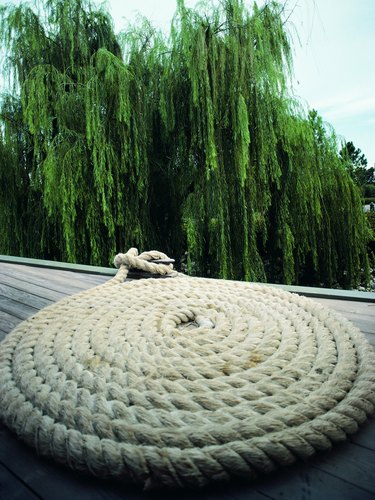
There are about 400 species of deciduous shrubs and trees in the genus Salix, including the graceful weeping willow (Salix babylonica). Weeping willows are susceptible to many fungal diseases and a few bacterial diseases, but only cotton root rot ordinarily causes them to die within hours or days. Cytospora canker (Cytospora chrysosperma), crown gall (Agrobacterium tumefaciens) and a deficiency of iron can also kill weeping willow.
Cotton Root Rot
Video of the Day
The fungal disease cotton root rot (Phymatotrichum omnivorum), usually associated with cotton plants, can cause willows in the Southwestern U.S. to wilt suddenly and die. The disease strikes when soil temperatures reach 82 degrees F, at first causing the leaves to turn yellow or brown. The top leaves wilt in one or two days, followed by the lower leaves. Willows can then die suddenly with the leaves still attached. There is no known chemical treatment, and the fungus lingers in soil for years.
Video of the Day
Cytospora Canker
The fungus Cytospora chrysosperma can strike willows suffering from drought, freezing, severe pruning or other shock. Sunken cankers circle branches and stems, turning the bark brown, gray, reddish brown, yellow or black. The disease eventually can kill the branches and trees. Remove infected bark or limbs immediately, cleaning your equipment with alcohol. There is no known fungicide that can kill Cytospora chysosperma, although you can spray your tree with a fungicide containing copper after you prune dead areas.
Crown Gall
Crown gall, a bacterial disease, produces large, rough woody swellings called galls on the stems and crowns of young willow trees, deforming, stunting and even killing them. Crown gall is a common disease among willows in nurseries. There is no known practical way to treat crown gall.
Iron Deficiency
Plants need iron to produce chlorophyll, necessary to conduct photosynthesis, the process of turning carbon dioxide from the air into plant nutrients. If the soil pH where your weeping willow is planted is above 7, it might not absorb iron, causing the plant to suffer from iron deficiency called iron chlorosis. If that happens, the leaves of your tree will turn yellow and twigs will die. In time, iron chlorosis can kill the entire tree. Your treatment options include spraying iron on the leaves, adding it to the soil and injecting it directly into the tree.
Bacterial Twig Blight
Although it is usually not lethal, bacterium Pseudomonas saliciperda can cause the leaves of your weeping willow to wilt and turn brown and kill several inches of branch tips. The bacteria causes brown streaks and cankers on the wood where the bacteria spend the winter. Prune infected branches and spray with a fixed copper fungicide in the early spring.
Other Fungal Diseases
Cercospora sp or Gloeosporium sp can cause irregular spots to form on willow leaves.
Powdery mildew (Phyllactinia guttata and Unicinula salicis) causes a a white powdery growth on tender leaves and sprouts, becoming heavy late in the growing season.
Rust (Melampsora sp) causes yellow spots on the bottoms of leaves. This is not considered a serious disease of willow trees, although it can cause a heavy loss of leaves.
Tarspot (Rhytisma salicinum) forms thick, tar-like drops about 1/4 inch wide on willow leaves.
Willow anthractnose (Drepanopeziza sphaerioides) causes blackish spots and irregular black cankers on young stems.
Willow black canker (Glomerella miyabeana) can cause black cankers to appear on the stems of older trees.
Willow scab (Venturia saliciperda) can cause black spots on new growth and shriveled shoots.
It is not practical to spray older trees for fungal diseases. Spray younger trees with a fungicide containing copper or the active ingredients myclobutanil or triticonazole.
- Savatree: Willow Tree
- University of Illinois Extension: Cytospora Canker of Poplars and Willows
- University of Missouri Extension: Yellow Leaves, Iron Chlorosis
- Texas Plant Disease Handbook: Willow
- Royal Horticultural Society: Willow anthracnose, scab and canker
- Canadian Plant Disease Survey; Weeping Willow blight in coastal British Columbia; J. T. Hill et al.